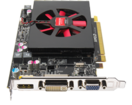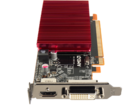- Joined
- Oct 9, 2007
- Messages
- 47,615 (7.45/day)
- Location
- Dublin, Ireland
| System Name | RBMK-1000 |
|---|---|
| Processor | AMD Ryzen 7 5700G |
| Motherboard | Gigabyte B550 AORUS Elite V2 |
| Cooling | DeepCool Gammax L240 V2 |
| Memory | 2x 16GB DDR4-3200 |
| Video Card(s) | Galax RTX 4070 Ti EX |
| Storage | Samsung 990 1TB |
| Display(s) | BenQ 1440p 60 Hz 27-inch |
| Case | Corsair Carbide 100R |
| Audio Device(s) | ASUS SupremeFX S1220A |
| Power Supply | Cooler Master MWE Gold 650W |
| Mouse | ASUS ROG Strix Impact |
| Keyboard | Gamdias Hermes E2 |
| Software | Windows 11 Pro |
AMD released the entire entry-mid portion of the Radeon HD 6000 series overnight, for OEMs only. The cards won't be available to consumers (retail) as yet, but does give away specifications of two new GPUs that AMD is carving these SKUs out of, Turks and Caicos. Built on the 40 nm process, Turks packs 480 VLIW5 stream processors, is DirectX 11 compliant, and sports a 128-bit wide GDDR5 memory controller that supports GDDR3 on lower SKUs. Radeon HD 6670 and HD 6570 are based on Turks. Both have all 480 stream processors enabled, differ in memory type/amount and clock speeds. The HD 6670 carries clock speeds of 800 MHz core, 1000 MHz (4.00 GHz GDDR5 effective) memory, and is available with memory amounts of 512 MB or 1 GB. The 128-bit wide memory interface churns out bandwidth of 64 GB/s.
The HD 6570 is also based on Turks, but features clock speeds of 650 MHz core, and two different memory clock speed specifications based on the memory type opted for by the manufacturers. If a manufacturer chooses GDDR3, it's clocked at 900 MHz (1.80 GHz GDDR3 effective), with a memory bandwidth of 28.8 GB/s. If it's GDDR5, it's clocked at 1000 MHz (4.00 GHz effective), 64 GB/s bandwidth. Up to 2 GB of memory can be opted for GDDR3 designs, while up to 1 GB can be opted for GDDR5-based ones. While the HD 6670 reference board uses a full-height design with a single-slot fan-heatsink, HD 6570 is designed for low-profile cards, best suited for HTPCs or SFF PCs.



Lastly, there's the HD 6450, which is based on the Caicos silicon. This is AMD's entry-level GPU, which is geared to be an IGP replacement or for users who just need a GPU that does everything an IGP does, faster. Caicos is an improvement over previous-generation Cedar. It features 160 VLIW5 stream processors, twice that of Cedar. It features a leaner 64-bit memory controller that supports GDDR5 and DDR3. Partners are free to set GPU clock speeds in the range of 625 MHz to 750 MHz, while its memory can be clocked at 533 to 800 MHz for DDR3, or 800 to 900 MHz for GDDR5. It is designed for cards that are both low-profile, and silent (passively-cooled). There's no information on retail release, but we can't imagine them to be too far away.
View at TechPowerUp Main Site
The HD 6570 is also based on Turks, but features clock speeds of 650 MHz core, and two different memory clock speed specifications based on the memory type opted for by the manufacturers. If a manufacturer chooses GDDR3, it's clocked at 900 MHz (1.80 GHz GDDR3 effective), with a memory bandwidth of 28.8 GB/s. If it's GDDR5, it's clocked at 1000 MHz (4.00 GHz effective), 64 GB/s bandwidth. Up to 2 GB of memory can be opted for GDDR3 designs, while up to 1 GB can be opted for GDDR5-based ones. While the HD 6670 reference board uses a full-height design with a single-slot fan-heatsink, HD 6570 is designed for low-profile cards, best suited for HTPCs or SFF PCs.



Lastly, there's the HD 6450, which is based on the Caicos silicon. This is AMD's entry-level GPU, which is geared to be an IGP replacement or for users who just need a GPU that does everything an IGP does, faster. Caicos is an improvement over previous-generation Cedar. It features 160 VLIW5 stream processors, twice that of Cedar. It features a leaner 64-bit memory controller that supports GDDR5 and DDR3. Partners are free to set GPU clock speeds in the range of 625 MHz to 750 MHz, while its memory can be clocked at 533 to 800 MHz for DDR3, or 800 to 900 MHz for GDDR5. It is designed for cards that are both low-profile, and silent (passively-cooled). There's no information on retail release, but we can't imagine them to be too far away.
View at TechPowerUp Main Site













